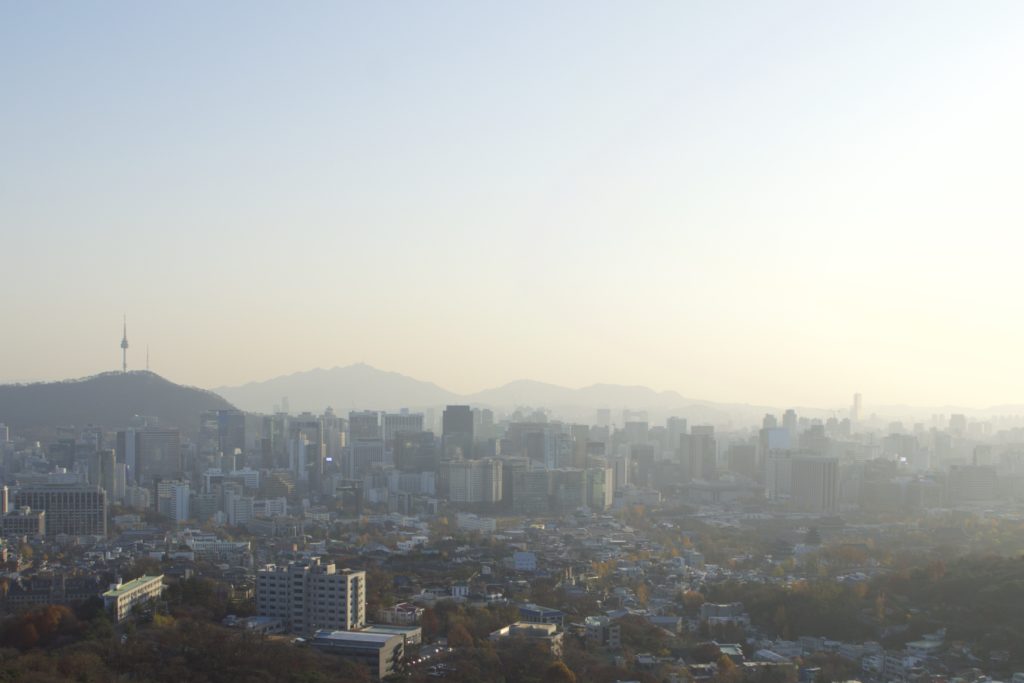The Peninsula
Hazy Shade of Winter: Air Pollution Sparks Emergency Measures in Korea

By Jenna Gibson
This week, Seoul’s residents were in a haze – literally. Dangerously high levels of particulate matter in the air prompted emergency measures from the Seoul city government, including making public transportation free during peak hours and asking residents to leave their cars in park as much as possible.
These policies are triggered based on the amount of PM2.5 in the air, with levels above 50 µg/m³ being considered unsafe. On Thursday morning, though, PM2.5 in Seoul hit 160 µg/m³, more than three times that level. Even before this week’s spike, the OECD announced that South Korea has the worst air quality among its members.
Good morning, Seoul air. I wish you could clean up your act, already. https://t.co/VRv5Ziaimq pic.twitter.com/VBjUEo4geB
— Matt Stiles (@stiles) January 16, 2018
The government’s emergency measures may have had limited success, however – according to Arirang, use of buses and subways increased by only 2.1 percent on Monday, and traffic only dropped 1.8 percent.
This was the first time emergency smog measures have been activated since the government announced their new policies in July 2017. Besides the free subway and bus rides, other measures include implementing an odd-even license plate program, where drivers alternate days they can be on the road depending on the last digit of their license plate, as well as upping environmental standards for industries like construction and heating/cooling.
The public discourse surrounding the pollution issue, however, doesn’t often zero in on these domestic industries as the source of the problem. Instead, many media reports about the air pollution problem mention particulates blowing over from China, picking up pollutants from the large country’s many factories before making its way to Seoul. However, a KEI analysis by Professor Matthew Shapiro suggests it’s more complicated than that: “While it is true that the pollution originates in China and is carried eastward on the trade winds, China is not the sole contributor to this problem. Rather, Korean investments in China and the subsequent exports of goods from firms in China all play a role,” he writes. “This is an urgent problem, requiring the cooperation of both countries to manage what is ultimately a regional pollution issue.”
The government is scrambling to get a handle on the pollution issue now not only because of public health, but also because of concerns with the PyeongChang Olympic Games starting in less than a month. To keep particulate levels low, an old theromoelectric power plant near the Olympic venues has been shut down until June, and the government is planning to deploy sensors around the PyeongChang area to measure pollution in real time.
Soulless Seoul air😷 pic.twitter.com/M18wtWrTVe
— Jihye Lee 이지혜 (@TheJihyeLee) January 17, 2018
Meanwhile, residents are finding ways to cope with the dangerously high pollution rates. After the government announced its first fine dust emergency day on Monday, stock shares of companies that make eye drops and face masks soared. Demand for clothing dryers is also on the rise – although many Koreans still air dry their clothes, concerns about pollution pushed the domestic market for dryers up 474 percent in 2017, according to e-commerce site Auction.
Realistically, offering free rides on the bus or subway is great as a temporary, emergency measure, and can be particularly helpful for those on the lower end of the income spectrum who may be forced to walk in the polluted air if they can’t afford to pay for public transportation. However, not only is it not financially feasible for the Seoul city to offer free rides on a long-term basis, it also does nothing to solve the underlying problem of emissions generated both in Korea and blowing in from abroad.
Although it may take more than a few days of free rides to change people’s habits, clearly the measure didn’t incentivize that many drivers to leave their cars at home for the day. The Korean government, coordinating closely with major cities like Seoul, is going to have to step up their attention to this issue, and find ways to address the root of the problem, whether through domestic or diplomatic efforts.
Jenna Gibson is the Director of Communications at the Korea Economic Institute of America. The views expressed here are the author’s alone. Image taken by Jenna Gibson.
